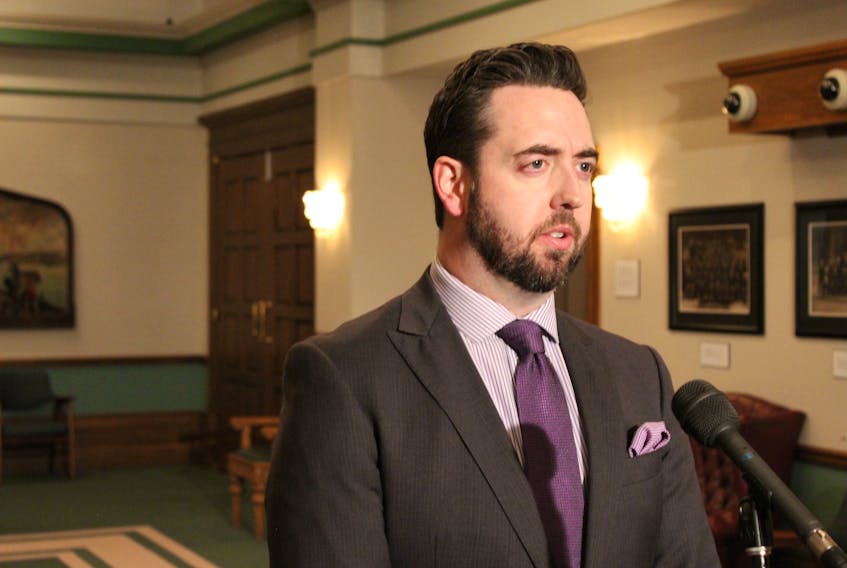ST. JOHN'S, N.L. — A great deal has been said about the age of Her Majesty’s Penitentiary (HMP) in St. John’s, of how the facility isn’t modern, and isn’t supportive of rehabilitation.
By comparison, little has been said about the legislation – the law – governing what happens inside the walls of HMP and other corrections facilities in Newfoundland and Labrador.
The Prisons Act was proclaimed 50 years ago, with little update since.
In 2011, the Correctional Services Act was introduced. It was meant to replace both the old Prisons Act (proclaimed in 1969) and the Adult Corrections Act (1975).
At that time, justice minister Felix Collins described the older laws to the House of Assembly: “They do not reflect contemporary practice, and they are silent on issues which should be codified in law,” he said before presenting the details of the new act.
The more modern piece of legislation sailed through the House. It passed without amendment. But it was never proclaimed. It has never come into force.
Creating the new legislation involved a “jurisdictional scan” by Justice staff for best practice across Canada, interdepartmental consultations and at least 19 meetings collecting input from 27 different stakeholder groups. But after the legislation passed, it was left to rot.
The “Deaths in Custody” report submitted to the government in December 2018, and released to the public earlier this year, listed “modernization of the legislation” as being an “outstanding issue.”
“In 2008, it was noted in the Decades of Darkness report that the (existing) legislation uses outdated corrections terminology. It does not reflect a rehabilitative approach to managing inmates, nor does it recognize nor protect the rights of inmates,” retired RNC Supt. Marlene Jesso stated in her report.
Her No. 1 recommendation was that the government take immediate steps to proclaim the Correctional Services Act and ensure all associated regulations and policies are updated.
Justice Minister Andrew Parsons told The Telegram on Wednesday the government will seek to make some changes, before the modern act is finally proclaimed, through amendments to be introduced in this spring session of the House of Assembly. Further details will come when the proposed changes are tabled.
He said the Liberal government plans to see modern legislation enacted.
How different is the Correctional Services Act of 2011 from what the province is still operating under?
“The search of inmate's clothing, search of his cell, search of belongings, these are all standard activities within a correctional facility, but the proper guidelines for searches, including strip search, are laid out in the new act,” Collins said when introducing it in 2011.
“As well … the act lays out the procedure to conduct routine searches of visitors entering or leaving the facility, guidelines for that. The act as well has a provision for the search of staff members. None of this was in any of the previous legislation,” he said.
While the activities are covered today by internal policies and procedures, these are not detailed in public documents, not associated with legislated penalties, not well known by all visitors or universally followed by staff. As Jesso reported, policies and standing orders at HMP and the prison in Clarenville have generally been updated in “piecemeal” fashion and are “often breached.”
The new law, if it remains in any way close to its current form, allows for drug testing of inmates and offers guidelines for the reasonable use of force by a corrections officer.
Aboriginal offenders and female offenders — not mentioned in the province’s Prisons Act — are mentioned in the Correctional Services Act.
The new law protects privileged communications. It protects, for example, communications by an inmate with the Office of the Citizens' Representative, so they shall not be read, listened to or otherwise monitored by staff (who are at times the subject of complaints).
The citizens’ representative remains at the heart of the existing system, but the new law offers the addition of an independent, internal grievance process for inmates, doing away with an existing, internal complaints review that Collins said would at times be described as a “kangaroo court.”
The new law offers a new inmate disciplinary process, with independent adjudicators.
“This new procedure will involve the hiring of a full-time hearing adjudicator from outside of corrections to adjudicate all offences in which internal charges have been laid against an inmate, a new and innovative system of discipline,” Collins said in 2011.
So, why isn’t all this already in place?
By the time Parsons took over at Justice, after the Liberals took power at the end of 2015, years had already passed. If the Correctional Services Act had been enacted the year it passed, it would have already been due for a five-year review. And the basic work needed to bring it into force was also not done by the Progressive Conservatives, Parsons said.
“There was no regulations done. Absolutely none. So my frank assessment of it is that they brought in a piece of legislation that clearly wasn’t ready to be utilized. There was no regulations done, and I don’t know if there was any costing done,” Parsons said this week.
His father had described the regulations in 2011 as “the meat, the bones, the muscle” of the new law. According to Kelvin Parsons, the House only settled on “the skeleton” in 2011.
And cost was an issue.
“I don’t know what went on between 2011 and 2015. From what I can gather, the act is great in theory, but it contained a significant price tag for some of the actions that they just had not budgeted,” Andrew Parsons said, specifically referencing as an example the cost associated with independent adjudicators for a new disciplinary process at provincial prisons.
“We came in and said, OK, where are we right now? In January of 2016? And let’s go from there,” he said.
“Things didn’t stay the same. Because the legislation was not proclaimed does not mean changes were not made.”
Parsons gave direction for staff to respond to and focus on a series of other, associated concerns arising within Justice. In early 2016, for example, a spike in female inmates required a response, with changes at HMP, to reintroduce women at that facility. There were renovations, the establishment of policies and development of on-site programming for female inmates.
He directed a review of the disciplinary segregation policy, an administrative review and work to support the all-party committee on mental health and addictions, with subsequent follow-up on recommendations.
“So we’re doing all these things … and now we have a new amendment to that (Correctional Services Act) that is ready to come,” he said.
And 50 years on, the new law might finally arrive.
RELATED STORIES:
New alternative measures program for adult offenders accepts first cases
N.L. correctional officers need training, says report









